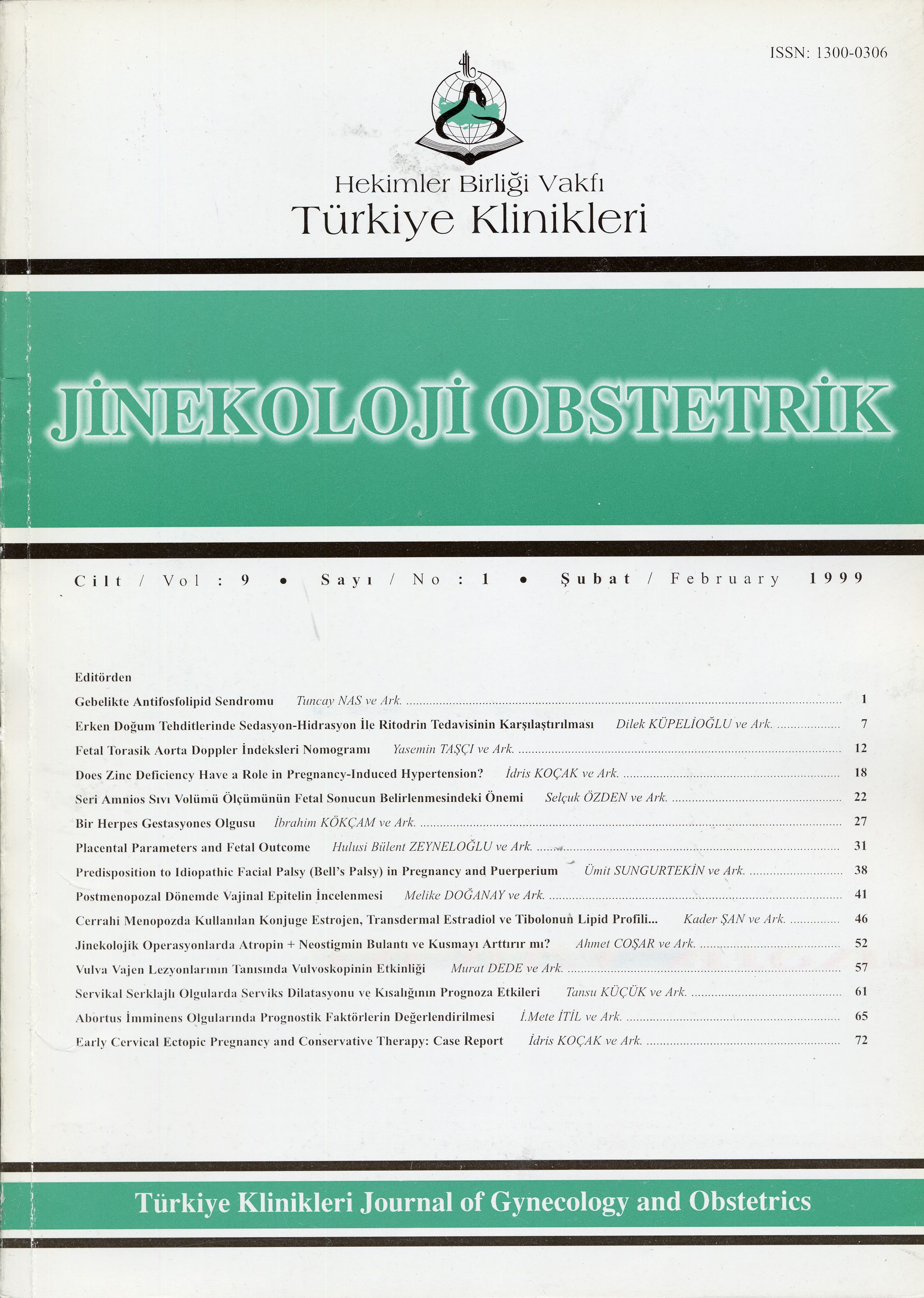Open Access
Peer Reviewed
ARTICLES
3133 Viewed1194 Downloaded
Effects Of Cervical Dilatation And Shortage OnPrognosis Of Patients With Cervical Cerclage
Servikal Serklajlı Olgularda Serviks Dilatasyonuve Kısalığının Prognoza Etkileri
Turkiye Klinikleri J Gynecol Obst. 1999;9(1):61-4
Article Language: TR
Copyright Ⓒ 2025 by Türkiye Klinikleri. This is an open access article under the CC BY-NC-ND license (http://creativecommons.org/licenses/by-nc-nd/4.0/)
ÖZET
Amaç: Serklaj sütürü konan hastalarda obstetrik performansı incelemek. Çalışmanın Yapıldığı Yer: GATA - Ankara ve GATA - Haydarpaşa, Kadın Hastalıkları ve Doğum klinikleri. Materyel ve Metod: Serviksin sadece kısa (<20 mm) olduğu 177 olgu (Grup I) ve hem kısa hem de dilate (6 no Hegar buji geçişi) olduğu 102 olguya (Grup II) McDonald prosedürü uygulanmıştır. Bulgular: Geç abortus, immatür doğum, erken doğum tehdidi, erken membran rüptürü, erken doğum ve term doğum oranları Grup Ide sırasıyla %1.1, %1.1, %24.2, %5, %10.1, ve %82 iken, Grup IIde aynı oranlar sırasıyla %1.9, %2.9, %52.9, %10.7, %22.5, %61 olarak saptanmıştır. Sonuç: Serviksin hem kısa hem de dilate olduğu olgularda serklaj sütürü konmalı ve özellikle Grup II olgular daha yakın ve tersiyer merkezlerde izlenmelidir.
Amaç: Serklaj sütürü konan hastalarda obstetrik performansı incelemek. Çalışmanın Yapıldığı Yer: GATA - Ankara ve GATA - Haydarpaşa, Kadın Hastalıkları ve Doğum klinikleri. Materyel ve Metod: Serviksin sadece kısa (<20 mm) olduğu 177 olgu (Grup I) ve hem kısa hem de dilate (6 no Hegar buji geçişi) olduğu 102 olguya (Grup II) McDonald prosedürü uygulanmıştır. Bulgular: Geç abortus, immatür doğum, erken doğum tehdidi, erken membran rüptürü, erken doğum ve term doğum oranları Grup Ide sırasıyla %1.1, %1.1, %24.2, %5, %10.1, ve %82 iken, Grup IIde aynı oranlar sırasıyla %1.9, %2.9, %52.9, %10.7, %22.5, %61 olarak saptanmıştır. Sonuç: Serviksin hem kısa hem de dilate olduğu olgularda serklaj sütürü konmalı ve özellikle Grup II olgular daha yakın ve tersiyer merkezlerde izlenmelidir.
ANAHTAR KELİMELER: Servikal yetmezlik, servikal kısalık, servikal dilatasyon, serklaj, obstetrik performans
ABSTRACT
Objective: To analyze the obstetrical performance in patients with cervical cerclage. Institution: Departments Of Obstetrics and Gynecology, GATA - Ankara and GATA - Haydarpaşa. Materials and methods: 177 women with short cervical canal (<20 mm, Group I) and 102 women with both short and dilated (insertion of no 6 Hegars dilator, Group II) were included in this study. They all undergone McDonalds procedure. Results: Incidences of late abortion, immature birth, premature labor, premature rupture of membranes, premature birth and term birth were 1.1%, 1.1%, 24.2%, 5%, 10.1%, and 82% respectively in Group I, while 1.9%, 2.9%, 52.9%, 10.7%, 22.5% and 61% in Group II. Conclusion: Cerclage is indicated in women with short and/or dilated cervical canal. Particularly, patients in Group II should get antenatal visits in referral centers due to higher incidence of complications of all types.
Objective: To analyze the obstetrical performance in patients with cervical cerclage. Institution: Departments Of Obstetrics and Gynecology, GATA - Ankara and GATA - Haydarpaşa. Materials and methods: 177 women with short cervical canal (<20 mm, Group I) and 102 women with both short and dilated (insertion of no 6 Hegars dilator, Group II) were included in this study. They all undergone McDonalds procedure. Results: Incidences of late abortion, immature birth, premature labor, premature rupture of membranes, premature birth and term birth were 1.1%, 1.1%, 24.2%, 5%, 10.1%, and 82% respectively in Group I, while 1.9%, 2.9%, 52.9%, 10.7%, 22.5% and 61% in Group II. Conclusion: Cerclage is indicated in women with short and/or dilated cervical canal. Particularly, patients in Group II should get antenatal visits in referral centers due to higher incidence of complications of all types.
MENU
POPULAR ARTICLES
MOST DOWNLOADED ARTICLES





This journal is licensed under a Creative Commons Attribution-NonCommercial-NoDerivatives 4.0 International License.










